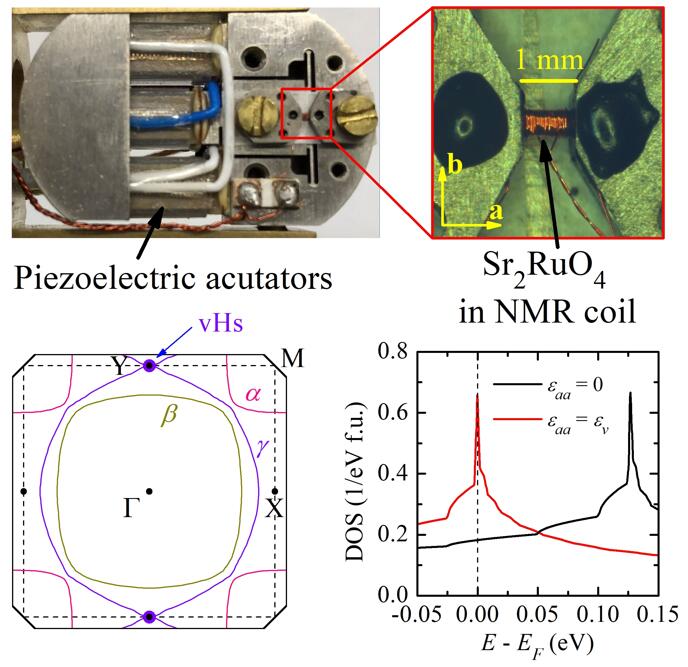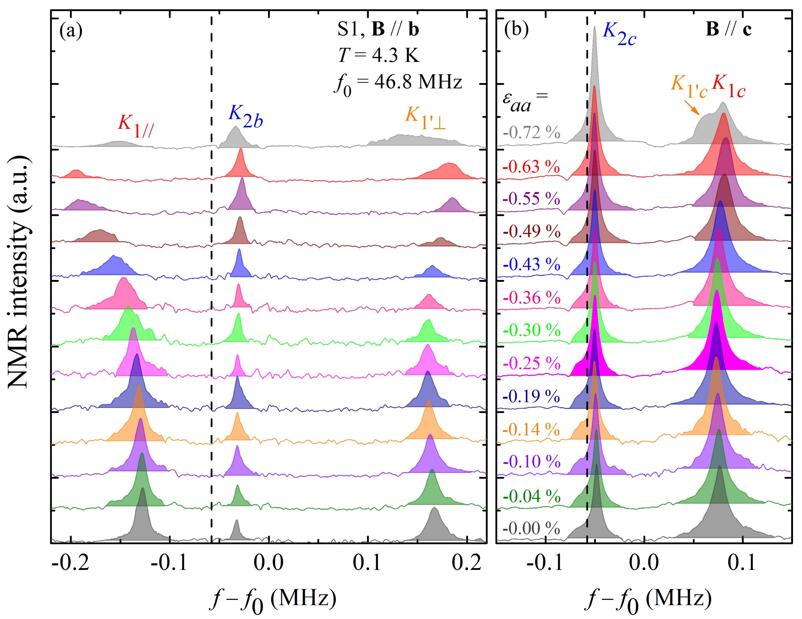
Fig. 1 The upper panel shows the set-up of the NMR experiment under uniaxial stress. The bottom panel shows the Fermi surface of Sr2RuO4. When approaching a van-Hove singularity, the density of state sharply increases.

Fig. 2 17O NMR spectra under strain, for 17O -1/2↔1/2 transition. The left panel is for B//b, and the right panel is for B//c.
(Phys. Rev. X 9, 021044, DOI:https://doi.org/10.1103/PhysRevX.9.021044)
Background
Sr2RuO4 is one of the most fascinating unconventional superconductors. Although it shares the same crystalline structure with single-layer high-Tc cuprates, its Tc value is much lower than that of the high-Tc. At the early stage of its discovery, theorists predicted ap-wave pairing state in Sr2RuO4. The experimental evidence forp-wave pairing came primarily from NMR Knight shift, the phase-sensitive, and later, cantilever magnetometry measurements. However, controversies on its precise pairing symmetry have persisted. For example, the absence of Tc vs. strain cusp near zero strain in the uniaxial strain measurements on Sr2RuO4 appears to suggest that a simplep-wave on a single-band is not likely to explain the experimental data assuming that no complications from the nonuniformity of the strains exist. Bulk and local experimental probes are needed to elucidate this critical issue.
What we discover?
The effects of uniaxial compressive stress on the normal state 17O nuclear-magnetic-resonance properties of the unconventional superconductor Sr2RuO4 are reported. The paramagnetic shifts of both planar and apical oxygen sites show pronounced anomalies near the nominala-axis strain εaa≡εv that maximizes the superconducting transition temperatureTc. The spin susceptibility weakly increases on lowering the temperature below T≃10 K, consistent with an enhanced density of states associated with passing the Fermi energy through a van Hove singularity. Although such a Lifshitz transition occurs in theγband formed by the Ru dxy states hybridized with in-plane O pπ orbitals, the large Hund’s coupling renormalizes the uniform spin susceptibility, which, in turn, affects the hyperfine fields of all nuclei. We estimate this “Stoner” renormalizationSby combining the data with first-principles calculations and conclude that this is an important part of the strain effect, with implications for superconductivity.
Why is this important?
This work is important for two reasons. First, because NMR measurements are both bulk and local, we thus provide solid evidence for a strain-induced van Hove singularity. Second, the normal state investigation has two ramifications: In the first approximation, this effect strongly favors some singlet pairings, such as extendeds,dzx±idyz, or dx2−y2 mildly favors the dxy pairing and less so any triplet pairing. However, this enhancement of the DOS through the Stoner factor boosts ferromagnetic spin fluctuations, which favors triplet states and seems to disfavor singlet pairing. This presumably would boost up new theoretical and experimental researches in the coming future.
Who did the research?
Yongkang Luo1,2*,A. Pustogow1, P. Guzman1, A. P. Dioguardi3, S. M. Thomas3, F. Ronning3,
N. Kikugawa4, D. A. Sokolov5, F. Jerzembeck5, A. P. Mackenzie5,6, C.W. Hicks5,
E. D. Bauer3, I. I. Mazin7, and S. E. Brown1†
1Department of Physics & Astronomy, University of California, Los Angeles, Los Angeles, California 90095, USA
2Wuhan National High Magnetic Field Center and School of Physics, Huazhong University of Science and Technology, Wuhan 430074, China
3Los Alamos National Laboratory, Los Alamos, New Mexico 87545, USA
4National Institute for Materials Science, Tsukuba 305-0003, Japan
5Max Planck Institute for Chemical Physics of Solids, Dresden 01187, Germany
6Scottish Universities Physics Alliance, School of Physics and Astronomy, University of St. Andrews, North Haugh, St. Andrews KY16 9SS, United Kingdom
7Code 6393, Naval Research Laboratory, Washington, D.C. 20375, USA
Acknowledgements
This work was supported in part by the Laboratory Directed Research and Development (LDRD) program of Los Alamos National Laboratory under Project No. 20170204ER. Y. L. acknowledges partial support through the LDRD and 1000 Youth Talents Plan of China. N. K. acknowledges the support from JSPS KAKNHI (Grant No. 18K04715). I. I.M. is supported by ONR through the NRL basic research program. This work is supported in part by the National Science Foundation.
(Grants No. DMR-1410343 and No. DMR-1709304).
